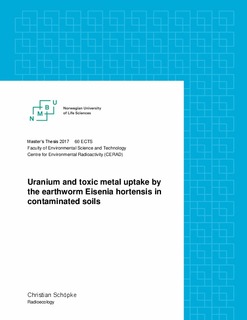| dc.contributor.advisor | Skipperud, Lindis | |
| dc.contributor.advisor | Wærsted, Frøydis Meen | |
| dc.contributor.advisor | Jensen, Louise Kiel | |
| dc.contributor.author | Schöpke, Christian Alexander | |
| dc.coverage.spatial | Norway, Orrefjell | nb_NO |
| dc.date.accessioned | 2017-08-16T08:30:42Z | |
| dc.date.available | 2017-08-16T08:30:42Z | |
| dc.date.issued | 2017 | |
| dc.identifier.uri | http://hdl.handle.net/11250/2450861 | |
| dc.description.abstract | Earthworms are present in nearly every terrestrial ecosystem worldwide and play an important role in the transport and availability of nutrients and other elements in soil. Even more ubiquitous than earthworms are naturally occurring radioactive material (NORM) and toxic metals – elements that are present in all soils, albeit in widely varying concentrations. These elements often can be found in a bound state (e.g. within a rock matrix), but can as a result of both natural and anthropogenic processes (e.g. mining and construction, wood burning, weathering) become more readily accessible for uptake in living organisms.
The aim of this study was to explore uptake of Mg, K, S, Zn, Cu, Cr, Mn, Co, Mo, V, Ni, As, Cd, Sn, Pb and U in varying degrees of contaminated soil by the earthworm species Eisenia hortensis in a laboratory setting. Furthermore, we wanted to compare uptake observed in the laboratory to uptake in earthworms sampled in the same soil as used in one of the laboratory treatments, chosen for its known high natural uranium (U) concentration. A control soil was collected from an area with low concentrations of NORM and toxic metals (Romeriksåsen), and the soil from the high U region (Orrefjell) was mixed with alum shale from Gran, Hadeland, to give a gradient of toxic metals and a stable high U concentration.
It was shown that increasing the metal concentration while maintaining a stable high U concentration had no effect on the assimilation of U by E. hortensis. In addition, increased mortality and decreased reproductive health were observed at the highest concentrations of metals tested, while at lower levels a positive effect on reproductive health was observed. Metal and NORM uptake in laboratory and field-sampled earthworms in the same soil was constant for most elements, with an increased concentration in laboratory earthworms for Co and Pb. | nb_NO |
| dc.description.abstract | Meitemark er å finne i de fleste terrestriske økosystemer og er viktige for transport og tilgjenglighet av næringsstoffer og andre grunnstoffer i jord. Enda mer utbredt enn meitemark er «naturlig forekommende radioaktivt materiale (NORM)» og giftige metaller - grunnstoffer som finnes i alle typer jord, men i vidt forskjellige konsentrasjoner. Disse grunnstoffene er ofte sterkt bundet i mineraler eller andre matriser i jord, men kan bli mer tilgjengelige som resultat av menneskelige og naturlige prosesser (for eksempel gruvedrift, bygg- og annleggsvirksomhet, forbrenning av fossilt materiale, forvitring).
Målet av denne studien var å undersøke opptak av Mg, K, S, Zn, Cu, Cr, Mn, Co, Mo, V, Ni, As, Cd, Sn, Pb og U fra jord kontaminert i ulik grad til meitemarkarten Eisenia hortensis i laboratorieforsøk. I tillegg var det ønskelig å sammenligne opptak observert i laboratoriet med opptak i mark prøvetatt i felt i samme jord – jord som ble valgt på grunn av kjent høy urankonsentrasjon. Kontrolljord ble hentet fra et område med lave konsentrajoner av NORM og giftige metaller (Romeriksåsen), og jord med høyt uraninnhold (Orrefjell) ble blandet sammen med alunskifer fra Gran (Hadeland) for å skape en gradient av giftige metaller og en stabil høy urankonsentrasjon.
Økende metallkonsentrasjoner i jord med en stabil høy urankonsentrasjon hadde ingen påvirkning på opptak av uran i E. Hortensis. Økt dødlighet og lavere reproduksjon ble observert i jorden med høyest innhold av metaller, mens i jorden med middels innhold av metaller ble det observert en positiv effekt på reproduktivitet. Opptak av metaller og NORM i laboratorie- og feltprøver var tilnærmet likt for de fleste grunnstoffer, med unntak av Co og Pb som ble tatt opp i større grad av mark i laboratorieforsøket. | nb_NO |
| dc.language.iso | eng | nb_NO |
| dc.publisher | Norwegian University of Life Sciences, Ås | nb_NO |
| dc.rights | Attribution-NonCommercial-NoDerivatives 4.0 Internasjonal | * |
| dc.rights.uri | http://creativecommons.org/licenses/by-nc-nd/4.0/deed.no | * |
| dc.subject | Earthworm | nb_NO |
| dc.subject | Eisenia hortensis | nb_NO |
| dc.subject | Concentration Ratio | nb_NO |
| dc.subject | NORM | nb_NO |
| dc.subject | Metals | nb_NO |
| dc.title | Uranium and toxic metal uptake by the earthworm Eisenia hortensis in contaminated soils | nb_NO |
| dc.type | Master thesis | nb_NO |
| dc.subject.nsi | VDP::Mathematics and natural science: 400::Zoology and botany: 480::Ecotoxicology: 489 | nb_NO |
| dc.subject.nsi | VDP::Mathematics and natural science: 400::Chemistry: 440::Environmental chemistry, natural environmental chemistry: 446 | nb_NO |
| dc.source.pagenumber | 70 | nb_NO |
| dc.description.localcode | M-RAD | nb_NO |

